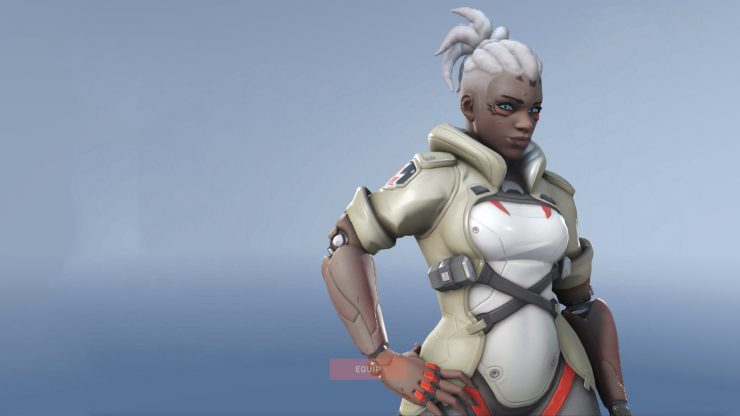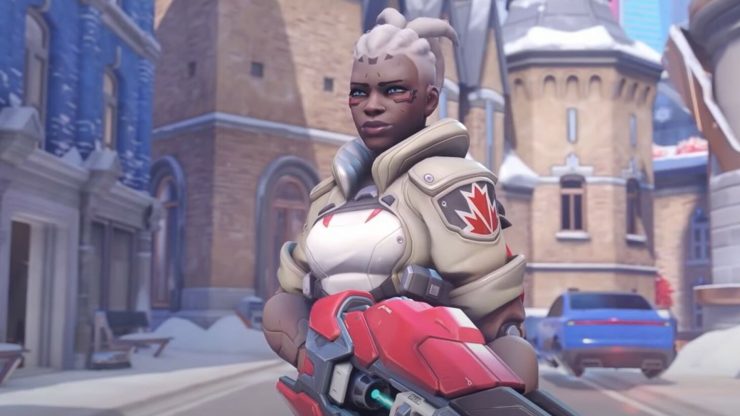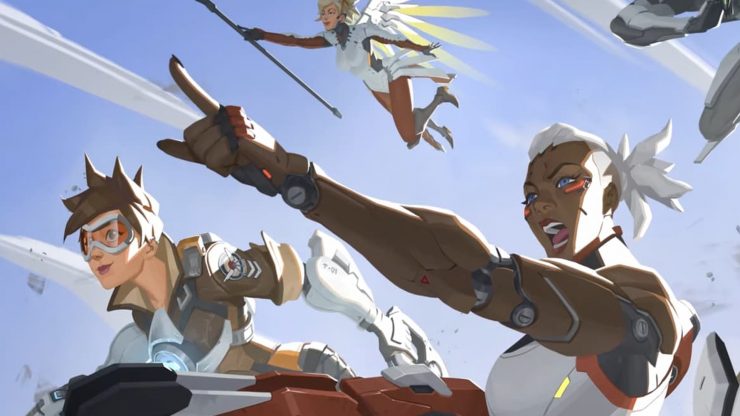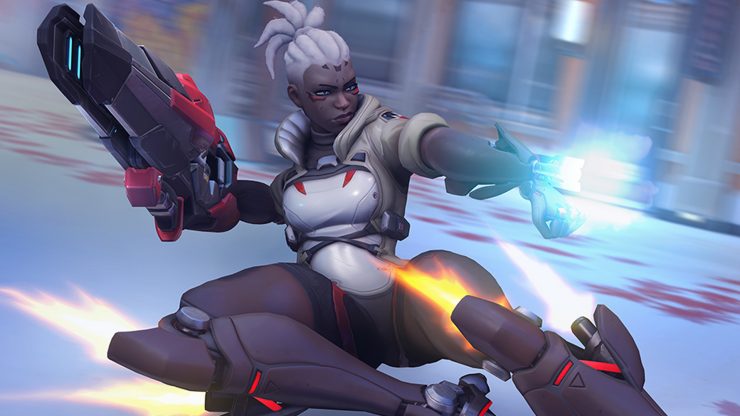Overwatch 2 promises to bring patient fans of the online shooter a whole deluge of new characters, with the very first among them, Sojourn, being playable in the game’s first PvP beta. For those who managed to access the Overwatch 2 beta, and for those awaiting the beta’s future plans for a chance to play, the Canadian cybernetic soldier offers a wide array of new hero abilities to get the hang of.
That’s why we’ve compiled this Sojourn guide, fully loaded with the best tips and tricks for mastering Overwatch’s latest hero. For damage players looking to achieve victory in the beta’s unranked mode, and for future Overwatch 2 players looking to unlock this railgun-toting hero’s full competitive potential, these tips and tricks will put you at an advantage in every teamfight.
Keep in mind that all heroes are subject to change as we near Overwatch 2’s release date, and this seems especially true for Sojourn, who the developers have already labelled as “a balancing nightmare.” The following tips and tricks reflect Sojourn’s build in the beta, which latecomers may still be able to join by claiming Overwatch 2 beta codes from Overwatch League when it returns this year.
Sojourn Guide – Tips and Tricks

Master the Power Slide jump
Sojourn’s abilities are easier to understand in terms of utility when compared with her in-lore colleague, Soldier: 76. What Soldier flaunts in his sprint running ability, Sojourn matches with her mobility-oriented Power Slide ability.
This might seem like a bit of a downgrade for Sojourn at face value since her Power Slide only travels a set distance and is tethered to a cooldown, while Soldier can run free as an ostrich. Sojourn’s true trump card, however, is in her ability to cancel the ability mid-slide, turning it into a rocket-powered jump, granting her not only a zippy way to traverse each map horizontally but also a means to access vertically advantageous high ground at any time.
This gives Sojourn more flexibility in teamfights and makes her an ideal surrogate for hitscan players looking to take advantage of maps with more vertical sweet spots, like Numbani, Havana, and Dorado. Where Soldier 76 can be dislodged from a high spot by a savvy Winston or Widowmaker, Sojourn can pass easily between high and low ground, and this versatility will make her a must-pick on certain maps. Simply activate your Power Slide, then jump to take advantage of her heightened mobility.
Make a Power Slide retreat
Much like Tracer’s Blink ability, Sojourn’s Power Slide can be used in multiple directions around her. Any solid Tracer player will know that the best approach isn’t simply to keep blinking forward and sideways for better angles of attack; instead, if you’re confident enough in your spatial awareness to know there’s solid space to retreat to, and secure enough in your enemy counting to know that there’s no one flanking around you, then simply Blink backwards without turning away from the fight.
This tactic keeps your front covered as you retreat, allowing you to continue firing at enemies as you move, and helping you to move into a more advantageous position with which to assess the larger teamfight before making your next play. The backwards Blink offers a tremendous amount of strategy in just one simple action – all of which is afforded to Sojourn players as well.
What Sojourn’s Power Slide lacks in Blink’s multiple charges and momentary invulnerability, it gains in the ability to turn that backwards retreat into a high jump, allowing everything we covered in our first tip to be applicable in reverse also. The skill ceiling for this combo is sky-high, as any player who can manage a well-timed retreat onto high ground without ever affording their teammates cover fire during a teamfight will surely become an invaluable asset.

Disruptor Shot gives you the 1v1 advantage
Sojourn’s Disruptor Shot ability allows her to fire an area-of-effect (AoE) orb that subjects all foes caught within its field to damage, while also applying a slowdown effect, making it easier to line up headshots or even full-team dives onto your newly-disadvantaged prey. In practice, however, it lacks the complete stalling power of Zarya’s Graviton Surge or Orisa’s now-defunct Halt! ability, making it rather unreliable in terms of coordinating assaults.
Where the ability has proven most effective, however, is when engaged in a 1v1 against a support hero or another damage hero. In a close-range duel, simply firing the AoE orb at your feet engulfs you and your foe in a bubble that costs them time and mobility to stay inside of. Combining this with a backwards Power Slide to put distance between you and your target can grant you a clean shot, and if you happen to have your Railgun charge ready to go (more on this tip later), it should be fairly easy to score a one-hit kill.
Keep in mind that this move is useful even when not in a position to take the fight. Should your health be very low, or your attacker be a little too meaty to take on in a 1v1 like Orisa, then simply use this strategy in combination with the Power Slide jump to cleanly break away from the fight and out of harm’s way. Take stock, get some heals, then rally for another round.
Think about your Disruptor Shot placement
The trickiest thing about the Disruptor Shot is how the projectile behaves upon firing. Unlike Ashe’s Dynamite or Junkrat’s Concussion Mine, the orb doesn’t have physical weight in the game, meaning it will travel directly across the map, unimpeded by gravity or a throwing arc. This makes it act a little like a cross between Symmetra’s Sentry Turrets, allowing it to move unphased in whatever direction you fire it, and Baptiste’s Immortality Field, which activates either when it reaches a certain thrown distance, or whenever it comes into contact with a surface – whichever happens first.
The trouble is in how the Disruptor Shot differs from those two abilities. Immortality Field, once active, rights itself into a set position from which to cover allies on the ground – whereas Disruptor Shot just activates wherever it activates, whether that’s a surface, an enemy’s face, or 10 feet in the air in a position completely devoid of threat. Sentry Turrets also travel indefinitely until they make contact with a surface and stay set indefinitely upon reaching their target, meaning a smart Symmetra player with keen aim can depend on their turrets to, at the very least, distract the enemy a little by forcing them to turn fire towards them.
Meanwhile, a badly placed, timed, or aimed Disruptor Shot will achieve no value at all in its limited window of activity, so Sojourn players need to be extra particular on just where and how they use it. For a safe result every time, try aiming at the ground beneath the enemy’s feet, rather than the enemy themselves. It might cost you a Power Slide jump to get a mid-air shot that positions the orb just right, but better that than having your ability miss completely and watching it activate several metres behind your target.

Fire away – shields count towards Railgun charge
While it’s neat to focus on all the trick cards Sojourn has up her detachable wrist flap, the truth is her ace will always be her Railgun. The character was designed from start to finish around her gun, so it was always going to be the star of the show here. To get any real utility out of the Sojourn at all, you’re going to need to wrap your head around the Railgun’s secondary fire.
While the primary fire allows you to shoot machine gun bullets, not unlike Soldier: 76, Sojourn’s secondary fire unleashes a devastating beam that will take a chunk of health if it connects, and boasts one-shot kill potential on most damage and support heroes if converted to a headshot. The catch is that the Railgun’s secondary fire is only available if you charge it, and it’s only going to be reliably deadly if you charge it to 100%.
Sojourn gains charge by landing shots with her primary fire, so you’re going to want to keep firing at the enemy to make that secondary fire available as soon as possible. If you’ve got the skills, you’ll charge up faster for landing headshots – a great incentive to work on your head-clicking game. However, if there’s a shield in your way, or the enemy is tucked behind cover – don’t panic. Shooting bodies and shields gains you charge too, so take whatever advantage you can and just keep firing until you get that secondary fire charge.
Play smarter, not harder, with a full Railgun charge
If a game, as Civilization’s Sid Meier famously said, is a series of interesting choices, then that qualifies Sojourn as a whole game unto herself. Not only do you have the choice to gain charge for a secondary fire, once charged you only have six seconds to choose whether to use it or build more charge before your meter decays. Then there’s the whole choosing the right moment within that six-second window ordeal, not to mention choosing where and who to hit – and that’s all before mentioning that you can choose to fire even if you don’t have full charge!
The ramifications of this are that you’ll find yourself tempted on almost every reload to eke out just a little more damage by committing whatever charge you’ve accrued thus far into a Railgun blast. This can be utilised very effectively in certain scenarios – particularly if you’re caught in a 1v1 and a small burst of damage makes the difference between a fight won and a fight lost.
However, if you’re wise and fortunate enough to be playing Sojourn at range, you’ll want to save up that charge until you get to 100%. Not only does the full charge grant you access to the Railgun’s full sniper-like headshot damage, but it also widens your shot’s blast ever-so-slightly. This means landing that headshot will feel far more generous than if you were playing as a traditional sniper like Widowmaker or Ashe, giving you a massive advantage that rewards playing smarter over playing harder.

Bolster your Overclock ultimate with primary fire
The pressure of using an ultimate can sometimes feel insurmountable, especially if it requires a modicum of skill to get any value out of it. Not only are you being judged by four teammates on your coordination and timing, but you also have to aim well and not die? Sure, there’s nothing more satisfying than a perfectly utilised Dragonblade from Genji, or a supremely savvy Infra-sight from Widowmaker, but there’s equally nothing more degrading than firing off an ult just as an Icicle from Mei embeds itself in your skull.
Anyone who has experienced the highs and lows of this exact process will be all the warier of Sojourn’s Overclock ultimate, which grants you an automatic charge for your secondary fire for a limited time, and also gives those Railgun blasts the power to pierce through several enemies at one time. All you have to do is aim your shots and not waste them – what could be easier?
The best advice to gleam here is to know when not to use the secondary fire while mid-ult. While your secondary fire does automatically charge, it can take a whole second or so to reach 100%, and if you fire too early, you’re wasting your ultimate’s full power. Instead, remember to alternate to your primary machine-gun-like fire between blasts. If an enemy is low on health, don’t waste a blast on them – finish them off with a little primary fire, and save your big shots for the areas where the enemy has clustered together, so you can get as much value out of that one shot as possible.
With all this Sojourn knowledge on board, plus a little practice time to get a feel for her cooldowns, you should be able to make the best of Overwatch 2’s latest hero. Make sure to check out our Overwatch tier list for a rundown on where Sojourn fits in once the new game releases.
